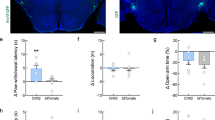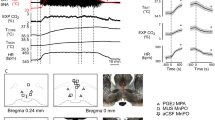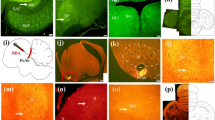Abstract
THE mammalian lateral hypothalamic area (LH) and the ventromedial hypothalamic nucleus (VMH) are involved in feeding and satiety function, respectively1. There is also reciprocity of electrical activity between the two2. Anatomically related to these areas, the amygdala has been shown to be involved in the same functions. Lesions of the basolateral nucleus of the amygdala results in hyperphagia3, while its electrical stimulation arrests feeding behaviour4. The stimulation of the amygdala also produces changes in the spontaneous discharge pattern of LH units, suggesting an inhibition or an activation–inhibition sequence between the LH and the amygdala5,6. We report here evidence that the inhibitory effect of the amygdala on the LH neurone is due to a long lasting inhibitory postsynaptic potential (IPSP) exerted through the stria terminalis.
This is a preview of subscription content, access via your institution
Access options
Subscribe to this journal
Receive 51 print issues and online access
$199.00 per year
only $3.90 per issue
Buy this article
- Purchase on Springer Link
- Instant access to full article PDF
Prices may be subject to local taxes which are calculated during checkout
Similar content being viewed by others
References
Anand, B. K., and Brobeck, J. R., Proc. Soc. Exp. Biol. Med., 77, 323 (1951).
Oomura, Y., Ooyama, H., Yamamoto, T., and Naka, F., Physiol. Behav., 2, 97 (1967); Oomura, Y., Ooyama, H., Naka, F., Yamamoto, T., Ono, T., and Kobayashi, N., Ann. NY Acad. Sci., 157, 666 (1969).
Morgane, P. J., and Kosman, A. J., Amer. J. Physiol., 198, 1315 (1960).
Fonberg, E., and Delgado, J. M. R., J. Neurophysiol., 24, 651 (1961).
Oomura, Y., Ooyama, H., Yamamoto, T., Naka, F., Kobayashi, N., and Ono, T., in Structure and Function of the Limbic System, Prog. in Brain Res. (edit. by Adey, W. R., and Tokizane, T.), 27, 1 (Elsevier, Amsterdam, 1967); Murphy, J. T., Dreifuss, J. J., and Gloor, P., Amer. J. Physiol., 214, 1443 (1968).
Oomura, Y., Ooyama, H., Yamamoto, T., Ono, T., and Kobayashi, N., Ann. NY Acad. Sci., 157, 642 (1969).
Fein, H., IEEE Transactions on Bio-medical Engineering, BME-13, 211 (1966).
König, J. F. R., and Klippel, R. A., The Rat Brain (Baltimore, Williams and Wilkins, 1963).
Andersen, P., Eccles, J. C., Schmidt, R. F., and Yokota, T., J. Neurophysiol., 27, 78 (1964).
Cowan, W. M., Raisman, G., and Powell, T. P. S., J. Neurol. Neurosurg. Psychiat., 28, 137 (1965).
Andersen, P., Eccles, J. C., and Løyning, Y., J. Neurophysiol., 27, 592 (1964); Araki, T., and Terzuolo, C. A., ibid., 25, 772 (1962).
Author information
Authors and Affiliations
Rights and permissions
About this article
Cite this article
OOMURA, Y., ONO, T. & OOYAMA, H. Inhibitory Action of the Amygdala on the Lateral Hypothalamic Area in Rats. Nature 228, 1108–1110 (1970). https://doi.org/10.1038/2281108a0
Received:
Revised:
Issue Date:
DOI: https://doi.org/10.1038/2281108a0
Comments
By submitting a comment you agree to abide by our Terms and Community Guidelines. If you find something abusive or that does not comply with our terms or guidelines please flag it as inappropriate.



